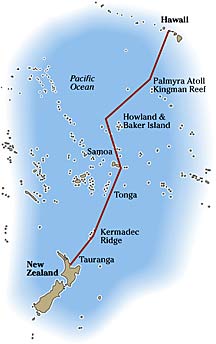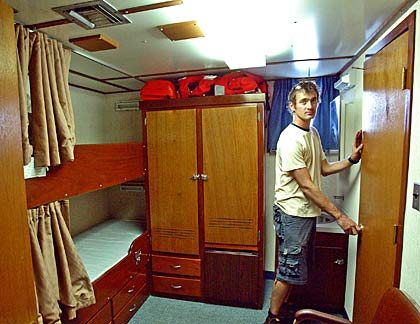
|
Deep-sea expedition
A 120-day research trip
to a string of submarine
volcanoes will test
two UH mini-subs
The longest, most-challenging expedition in the Hawaii Undersea Research Laboratory's 25-year history will begin March 18.
HURL's mother ship, Ka'imikai-O-Kanaloa, will leave with submersibles Pisces IV and Pisces V for five months of explorations in the South Pacific.
![]()

"This is all completely new territory," said Terry Kerby, HURL operations director and chief pilot.
The undersea volcanoes on his dive plan are "black smokers" with intense hydrothermal plumes, fluids and minerals. They're larger and more active than Loihi, the seamount off the Big Island where he has been diving for 18 years, he said.
"We have developed pretty good survival skills for diving on Loihi," Kerby said. But the coming trip is "really pioneering. It's going to be completely new on every dive," he said.
Both submersibles (capable of diving 6,600 feet), the KOK's remotely operated vehicle RCV-150, SeaBeam mapping and water sampling systems will be used during the cruise. Test dives are scheduled off Oahu March 14-16.
About 50 to 60 dives are planned in the 120-day expedition, with a range of oceanographic work, including studies of fisheries, marine life, deep sea algae and corals, chemistry and sea floor mapping.
University of Hawaii anthropologists also will investigate the USS Chehalis, a shipwreck off American Samoa.
The venture is a dream come true for HURL Director Alex Malahoff, who took a sabbatical leave from UH in 2002 to try to organize such an effort.
"I knew the next frontier for this type of work would be in the South Pacific," he said in a telephone interview from New Zealand, where he is chief executive of the Institute of Geological and Nuclear Sciences Ltd. in Wellington. But to take HURL to the South Pacific, he said, "We had to have overseas participation and investment."
New Zealand and German scientists have contributed about half of the money for the South Pacific Research Cruise, he said.
John Wiltshire, acting HURL director, said the total cost is $4.4 million, with $2.8 million from the National Undersea Research Program, the National Oceanic and Atmospheric Administration's Office of Ocean Exploration and NOAA Fisheries. HURL is operated jointly by NOAA and the UH.

Microbiologist Matthew Stott of New Zealand checked out one of the crew's quarters in the subdeck of the Ka'imikai-O-Kanaloa yesterday.
Malahoff said the idea is to compare and try to understand the microbial life, hydrothermal processes and hydrobiology of the giant Pacific Ring of Fire volcanoes.
![]()

![]()
Alex Malahoff: HURL director says overseas participation in journey was essential
Kerby's submersible crew includes pilot Max Cremer and pilots-in-training Steve Price and Colin Wolleman. The three-person submersibles normally carry one pilot and two observers, but two pilots will be on the dives into active volcanoes, Kerby said.
The Tonga-Kermadec volcanic arc extends for 2,000 miles from near Samoa to the Kermadec Islands and on to New Zealand's North Island with at least 33 volcanoes, all but one under water.
"They're basically the same (as Kilauea), but 10 times the size and there's a whole row of these things," Wiltshire said.
The ship will work its way down the line of volcanoes from Samoa to the North Island of New Zealand, starting with Vailuluu, an underwater volcano growing on Samoa's hotspot similar to Loihi on Hawaii's hotspot. "No one has ever been to that one before," Kerby said.
Hubert Staudigel of the Scripps Institution of Oceanography will leave sampling instruments there that he will collect in Pisces dives on the way back to Hawaii.
[News] [Business] [Features] [Sports] [Editorial] [Do It Electric!]
[Classified Ads] [Search] [Subscribe] [Info] [Letter to Editor]
[Feedback]
